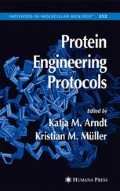Abstract
In designing protein libraries for selection, we must coordinate our capacity to create a large diversity of protein variants with the physical limitations of what we can actually screen. This chapter aims to bring the language of probabilities into the protein engineer’s laboratory to answer some of our common questions: How can we most efficiently design a library? What fraction of the theoretical library diversity have we actually sampled at the end of the day? What is the probability of missing an individual of the library? Are the mutations present in the variants we have selected statistically meaningful or the product of random variation? The computation of these criteria throughout the process of experimental protein engineering will enable us to better design and evaluate the products of our libraries of protein variants.
Access this chapter
Tax calculation will be finalised at checkout
Purchases are for personal use only
References
Arnold, F. H. and Georgiou, G. (2003) Directed Evolution Library Creation Methods and Protocols. Methods in Molecular Biology 231, Humana Press, Totowa, NJ.
Arnold, F. H. and Georgiou, G. (2003) Directed Enzyme Evolution Screening and Selection Methods. Methods in Molecular Biology 230, Humana Press, Totowa, NJ.
Moore, J. C., Jin, H. M., Kuchner, O., and Arnold, F. H. (1997) Strategies for the in vitro evolution of protein function—enzyme evolution by random recombination of improved sequences. J. Mol. Biol. 272, 336–347.
Moore, G. L. and Maranas, C. D. (2000) Modeling DNA mutation and recombination for directed evolution experiments. J. Theor. Biol. 205, 483–503.
Moore, G. L., Maranas, C. D., Lutz, S., and Benkovic, S. J. (2001) Predicting crossover generation in DNA shuffling. Proc. Natl. Acad. Sci. USA 98, 3226–3231.
Moore, G. L. and Maranas, C. D. (2002) Predicting out-of-sequence reassembly in DNA shuffling. J. Theor. Biol. 219, 9–17.
Sun, F. (1999) Modeling DNA shuffling. J. Comput. Biol. 6, 77–90.
Patrick, W. M., Firth, A. E., and Blackburn, J. M. (2003) User-friendly algorithms for estimating completeness and diversity in randomized protein-encoding libraries. Protein Eng. 16, 451–457.
Bittker, J. A., Le, B. V., Liu, J. M., and Liu, D. R. (2004) Directed evolution of protein enzymes using nonhomologous random recombination. Proc. Natl. Acad. Sci. USA 101, 7011–7016.
Gribskov, M., Devereux, J., and Burgess, R. R. (1984) The codon preference plot: graphic analysis of protein coding sequences and prediction of gene expression. Nucleic Acids Res. 12, 539–549.
Virnekas, B., Ge, L., Plückthun, A., Schneider, K. C., Wellnhofer, G., and Moroney, S. E. (1994) Trinucleotide phosphoramidites: ideal reagents for the synthesis of mixed oligonucleotides for random mutagenesis. Nucleic Acids Res. 22, 5600–5607.
Pelletier, J. N., Arndt, K. M., Plückthun, A., and Michnick, S. W. (1999) An in vivo library-versus-library selection of optimized protein-protein interactions. Nature Biotechnol. 17, 683–690.
Braunagel, M. and Little, M. (1997) Construction of a semisynthetic antibody library using trinucleotide oligos. Nucleic Acids Res. 25, 4690, 4691.
Gaytan, P., Yanez, J., Sanchez, F., and Soberon, X. (2001) Orthogonal combinatorial mutagenesis: a codon-level combinatorial mutagenesis method useful for low multiplicity and amino acid-scanning protocols. Nucleic Acids Res. 29, E9.
Ross, S. M. (1996) Stochastic Processes. 2nd ed., John Wiley & Sons, New York, NY.
Hogg, R. V. and Tanis, E. A. (1983) Probability and Statistical Inference. 2nd ed., MacMillan, New York, NY.
Ross, S. M. (1998) A First Course in Probability. 5th ed., Prentice Hall, Upper Saddle River, NJ.
Author information
Authors and Affiliations
Editor information
Editors and Affiliations
Rights and permissions
Copyright information
© 2007 Humana Press Inc.
About this protocol
Cite this protocol
Denault, M., Pelletier, J.N. (2007). Protein Library Design and Screening. In: Arndt, K.M., Müller, K.M. (eds) Protein Engineering Protocols. Methods in Molecular Biology™, vol 352. Humana Press. https://doi.org/10.1385/1-59745-187-8:127
Download citation
DOI: https://doi.org/10.1385/1-59745-187-8:127
Publisher Name: Humana Press
Print ISBN: 978-1-58829-072-4
Online ISBN: 978-1-59745-187-1
eBook Packages: Springer Protocols

